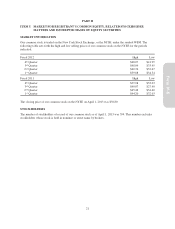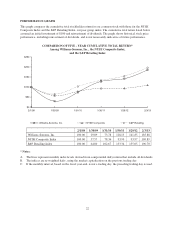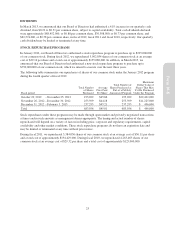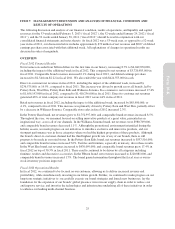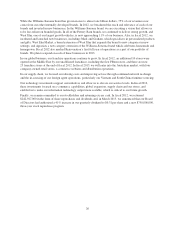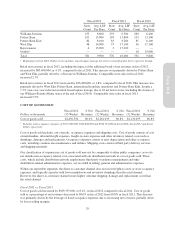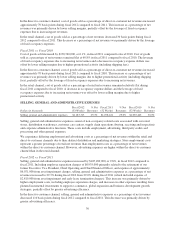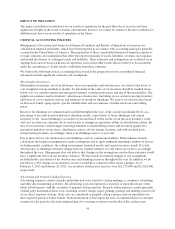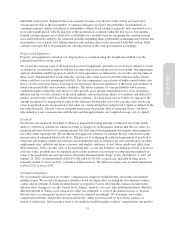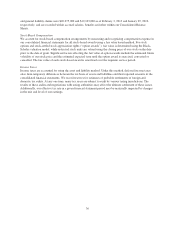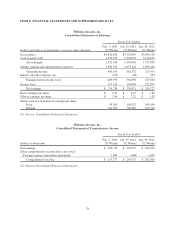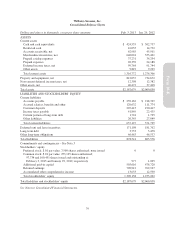Pottery Barn 2012 Annual Report Download - page 44
Download and view the complete annual report
Please find page 44 of the 2012 Pottery Barn annual report below. You can navigate through the pages in the report by either clicking on the pages listed below, or by using the keyword search tool below to find specific information within the annual report.
In the direct-to-customer channel, cost of goods sold as a percentage of direct-to-customer net revenues increased
approximately 70 basis points during fiscal 2012 compared to fiscal 2011. This increase as a percentage of net
revenues was primarily driven by lower selling margins, partially offset by the leverage of fixed occupancy
expenses due to increasing net revenues.
In the retail channel, cost of goods sold as a percentage of net revenues decreased 30 basis points during fiscal
2012 compared to fiscal 2011. This decrease as a percentage of net revenues was primarily driven by the leverage
of fixed occupancy expenses.
Fiscal 2011 vs. Fiscal 2010
Cost of goods sold increased by $130,740,000, or 6.1%, in fiscal 2011 compared to fiscal 2010. Cost of goods
sold as a percentage of net revenues remained flat at 60.8% in fiscal 2011 compared to fiscal 2010. The leverage
of fixed occupancy expenses due to increasing net revenues and a decrease in occupancy expense dollars was
offset by lower selling margins due to higher promotional activity (including shipping fees).
In the direct-to-customer channel, cost of goods sold as a percentage of direct-to-customer net revenues increased
approximately 70 basis points during fiscal 2011 compared to fiscal 2010. This increase as a percentage of net
revenues was primarily driven by lower selling margins due to higher promotional activity (including shipping
fees), partially offset by the leverage of fixed occupancy expenses due to increasing net revenues.
In the retail channel, cost of goods sold as a percentage of retail net revenues remained relatively flat during
fiscal 2011 compared to fiscal 2010. A decrease in occupancy expense dollars and the leverage of fixed
occupancy expenses due to increasing net revenues was offset by lower selling margins due to higher
promotional activity.
SELLING, GENERAL AND ADMINISTRATIVE EXPENSES
Dollars in thousands
Fiscal 2012
(53 Weeks)
% Net
Revenues
Fiscal 2011
(52 Weeks)
% Net
Revenues
Fiscal 2010
(52 Weeks)
% Net
Revenues
Selling, general and administrative expenses $1,183,313 29.3% $1,078,124 29.0% $1,050,445 30.0%
Selling, general and administrative expenses consist of non-occupancy related costs associated with our retail
stores, distribution warehouses, customer care centers, supply chain operations (buying, receiving and inspection)
and corporate administrative functions. These costs include employment, advertising, third party credit card
processing and other general expenses.
We experience differing employment and advertising costs as a percentage of net revenues within the retail and
direct-to-customer channels due to their distinct distribution and marketing strategies. Store employment costs
represent a greater percentage of retail net revenues than employment costs as a percentage of net revenues
within the direct-to-customer channel. However, advertising expenses are higher within the direct-to-customer
channel than in the retail channel.
Fiscal 2012 vs. Fiscal 2011
Selling, general and administrative expenses increased by $105,189,000, or 9.8%, in fiscal 2012 compared to
fiscal 2011. Including employee separation charges of $6,935,000 primarily related to the retirement of our
former Executive Vice President, Chief Operating and Chief Financial Officer, and expense of approximately
$6,071,000 from asset impairment charges, selling, general and administrative expenses as a percentage of net
revenues increased to 29.3% during fiscal 2012 from 29.0% during fiscal 2011 (which included expense of
$2,819,000 from asset impairment and early lease termination charges). This increase was primarily driven by
higher employment costs, including employee separation charges, and increases in other expenses resulting from
planned incremental investments to support e-commerce, global expansion and business development growth
strategies, partially offset by greater advertising efficiency.
In the direct-to-customer channel, selling, general and administrative expenses as a percentage of net revenues
decreased 110 basis points during fiscal 2012 compared to fiscal 2011. This decrease was primarily driven by
greater advertising efficiency.
30



